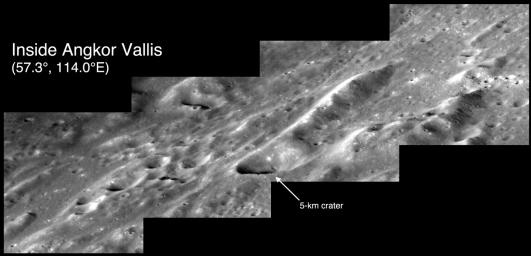
|
Inside Angkor Vallis
- Click the image above for a larger view
- Full-Res JPEG (1930 x 930) (174.9 kB)
- Full-Res TIFF (1930 x 930) (1.8 MB)
Caption:
The striking topography inside of Angkor Vallis is believed to have formed by hot, quick-flowing lavas moving across Mercury's surface. Shown here is a mosaic of four NAC images acquired from a grazing, highly oblique, viewing geometry of the surface. This provides a view that accentuates the height of the landforms within the volcanic valley.
This image was acquired as part of an MDIS campaign to obtain oblique views of Mercury's surface. Such views provide dramatic perspectives on Mercury's landscape.
Date acquired:
November 19, 2014
Image Mission Elapsed Time (MET):
58763153 - 58763159
Image ID:
7462444-7462447
Instrument:
Narrow Angle Camera (NAC) of the Mercury Dual Imaging System (MDIS)
Angkor Vallis Center Latitude:
57.3°
Angkor Vallis Center Longitude:
114.0° E
Scale:
A crater with a diameter of roughly 5 kilometers (3 miles) is noted in the mosaic
Center Incidence Angle:
64.0°
Center Emission Angle:
69.3°
Center Phase Angle:
38.5°
Background Info:
The MESSENGER spacecraft is the first ever to orbit the planet Mercury, and the spacecraft's seven scientific instruments and radio science investigation are unraveling the history and evolution of the Solar System's innermost planet. During the first two years of orbital operations, MESSENGER acquired over 150,000 images and extensive other data sets. MESSENGER is capable of continuing orbital operations until early 2015.
For information regarding the use of images, see the MESSENGER image use policy .
Cataloging Keywords:
| Name | Value | Additional Values |
|---|---|---|
| Target | Mercury | |
| System | ||
| Target Type | Planet | |
| Mission | MESSENGER | |
| Instrument Host | MESSENGER | |
| Host Type | Orbiter | |
| Instrument | Mercury Dual Imaging System (MDIS) | |
| Detector | Narrow Angle Camera (NAC) | |
| Extra Keywords | Crater, Grayscale, Radio, Volcano | |
| Acquisition Date | ||
| Release Date | 2015-01-07 | |
| Date in Caption | 2014-11-19 | |
| Image Credit | NASA/Johns Hopkins University Applied Physics Laboratory/Carnegie Institution of Washington | |
| Source | photojournal.jpl.nasa.gov/catalog/PIA19011 | |
| Identifier | PIA19011 | |
